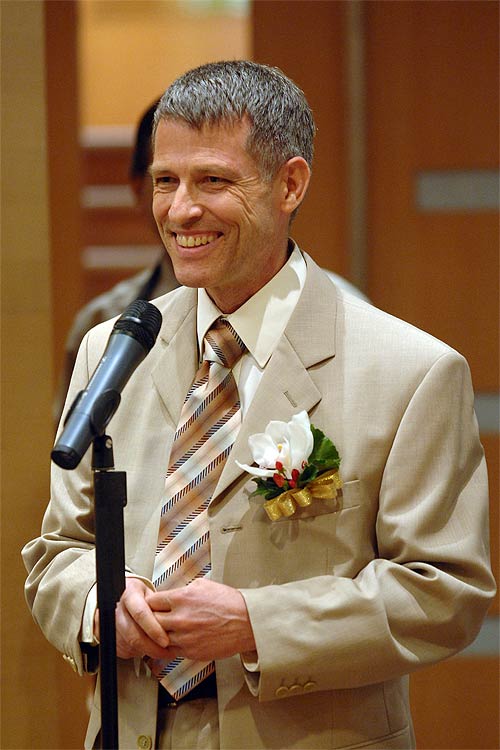Hare Krishna in a Chinese Classroom, by Oxford Don
By Venkatesan Vembu | Apr 22, 2008

HONG KONG: By day, Kenneth Valpey dons his academic robes to elevate his students at the Chinese University of Hong Kong to a higher orbit of understanding about Indian religions and cultures.
But come evening, he assumes another avatar. He slips into something a little more comfortable — like a pristine white dhoti-kurta and a wrap-around angavastram — and sermonizes on the Bhagavad Gita to the devotees of Krishna in Hong Kong.
Valpey’s ‘double life’ is easily explained: The theologian from the Oxford University has been appointed to professorship in Indian religions and culture at the Chinese University, established with a HK$4 million (about Rs2.2 crore) donation from the International Society for Krishna Consciousness (ISKCON) of Hong Kong.
And as a member of ISKCON, he joins other worshippers at the Krishna temple for the chanting and celebration that has practitioners across the world dancing in the streets.
The professorship was established by the university as part of an effort to “enhance exchanges between the East and the West,” says university pro vice-chancellor, Prof Liu Pak-wai. Under this programme, four courses are offered, including religious traditions in India, tradition and modernity in India, and self and identity in Indian culture.
Most of the graduate students at the Department of Cultural and Religious Studies are from mainland China, which is officially an atheist state and where freedom of religious worship is heavily circumscribed by the Communist Party.
In addition to classroom lectures and discussions, Valpey envisages field visits — he has taken his students to the Krishna temple — and a study tour to India.
On campus, he’s been screening Peter Brooks’ film The Mahabharata.
So, what relevance does the Bhagavad Gita have for Chinese students? “The essential teachings of the Gita,” says Valpey, “are relevant to everyone, and I think Chinese students are quite engaged by it.” In fact, he notes, a number of Chinese persons have been initiated into ISKCON.
Valpey himself was raised in the liberal Unitarian tradition in Berkeley, California, and was drawn to the Krishna consciousness movement when he dropped out of college in the late 1960s to “see a bit of the world”. Travelling in Europe, he met Krishna devotees, and was inspired enough by the teachings of the group’s founder Bhaktivedanta Prabhupada to be initiated into the movement. In 1972, as part of the rite of initiation, he was ‘christened’ Krishna Ksetra Das, which means “a servant of the places associated with Krishna’s life and, therefore, of Krishna himself.”
Valpey acknowledges that his embracing of the movement “might have been a result of the youthful enthusiasm for the exotic” that characterised the 1960s, the age of “flower power” and hippie nirvana. “But with the initiation came a certain commitment to follow a certain lifestyle, which has been very helpful,” he says.
Does that make him a ‘practising Hindu’? “Because the term ‘Hindu’ has certain connotations of cultural perspective, which are appropriate, I don’t mind being identified as a Hindu,” says Valpey. “But on the other hand, as soon as the term starts dividing me from others, I don’t want to be a ‘Hindu’ any more.”
More than two decades after his formal initiation into ISKCON, Valpey returned to university “to learn something about this religious tradition from an academic perspective.” He studied theology at Oxford University, and conducted his research at the Oxford Centre for Hindu Studies.
Academic engagement with religion did not create any dissonance with his practice, he says. “Of course, the academia is fraught with the hermeneutics of suspicion: That things are not the way they are presented within the tradition.” But there are two aspects to the study of religion, he says. “There’s the ‘cumulative tradition’ — which consists of everything visible and substantial, including religious texts, music, buildings, and so on. And then you have that which is invisible, but which is at the core of the tradition: Personal faith.” Ultimately, that remains “beyond the grasp of the scholar.”
Valpey believes the spiritual evolution he’s attained from his journey in Krishna consciousness was, in a sense, meant to be. “I like to think that Krishna’s hand is in our lives,” says the man who comfortably fuses a practitioner’s faith with scholarly investigation of that faith. “You may call him something else, but I’m accustomed to referring to that highest divinity as Krishna. So, there’s some intentionality, some plan.”
And when he’s imparting lessons on Indian religious traditions to a roomful of Chinese students, he’s only doing his “karmic duty”, he reckons. Hare Krishna to that…















